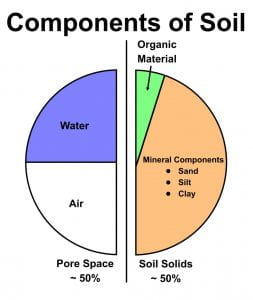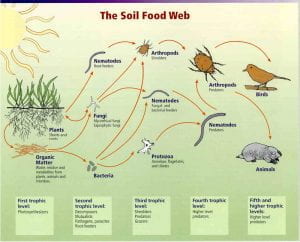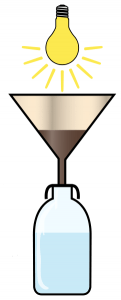Soil is such an important part of growing things and yet we often overlook it. Let’s take some time to learn more about it!
 What is soil made of?
What is soil made of?
There are four main components of soil:
- organic material (0-10 %)
- minerals (40-50 %)
- water (~25 %)
- air (~25 %)
Organic Material
 Most garden soils have 3-5 % organic matter. This includes both living, dead and decomposing plants, small animals and microorganisms. Soil is teeming with life, in fact there are more soil microorganisms in a teaspoon of healthy soil than there are people on earth!
Most garden soils have 3-5 % organic matter. This includes both living, dead and decomposing plants, small animals and microorganisms. Soil is teeming with life, in fact there are more soil microorganisms in a teaspoon of healthy soil than there are people on earth!
The soil food web starts with plant roots and organic matter. These are consumed by soil microbes (i.e. bacteria, fungi, protozoans), which in turn are eaten by small, sometimes microscopic, animals such as nematodes, earth worms, insects and mites. Continuing up the food chain, many of these creatures are snacks for small mammals and birds.
Here are two easy ways to explore soil dwelling creatures:

VIDEO: How to Make a Berlese Funnel – A Berlese funnel is used to extract small organisms from a soil sample. Once you’ve made your Berlese funnel, you add you soil sample and shine a light on it. As the soil dries out insects, mites and other small organisms will move downwards into the funnel and land in your collection jar.
VIDEO: How to Make a Pit Fall Trap – Pit fall traps are super easy to make. You’ll be surprised how what you find may vary greatly depending on where you put it (i.e. lawn, under a pine tree, vegetable garden, etc.) If you put a couple inches a water and and a few drops of dish detergent in the bottom, it will help prevent creatures from escaping, although it will kill your specimens.
 Minerals
Minerals
The minerals that make-up your soil vary depending on your location. The size of those particles also varies from place to place. There are three main particle sizes: sand, silt, and clay. To understand the difference in the sizes of these different particles, think of sand particles like basketballs, silt particles like golf ball, and clay particles like the head of a pin.
 If the soil is composed mostly of sand, there are large spaces or pores between the particles. This provides ample space for plant roots to easily grow and allows water to drain through very quickly, sometimes too quickly . If the soil is composed mostly of clay, there are very small pores making it more difficult for plants to grow and causing water drainage issues. A silty or loamy soil is preferred by most gardens as it still has ample space for plant roots to grow and water doesn’t drain to quickly or to slowly.
If the soil is composed mostly of sand, there are large spaces or pores between the particles. This provides ample space for plant roots to easily grow and allows water to drain through very quickly, sometimes too quickly . If the soil is composed mostly of clay, there are very small pores making it more difficult for plants to grow and causing water drainage issues. A silty or loamy soil is preferred by most gardens as it still has ample space for plant roots to grow and water doesn’t drain to quickly or to slowly.
Here are two fun activities that you can do to determine what sized particles you have in your soil.
Soil Texture – The Ribbon Test
Water and Air
Water and air make up about 50 % of the soil. This takes up all the space between the soil particles and organic materials. We just learned the size of soil particles determines the amount of space there is for water and air. Water is important for transporting nutrients to growing plants. It also makes the soil hospitable to a large variety of organism. The percentage of air and water varies as when water evaporates out of the soil, the spaces left behind don’t disappear, instead they are filled with air.
Learn even more about Soil!
Easy DIY Soil Tests – Washington State University
This resource includes more fun activities including tests for drainage, pH, and soil biology (featuring the underwear test!).
Organic Matter and Soil Amendments – University of Maryland Extension
Soil Health Nuggets – USDA